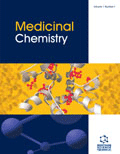Abstract
Mathematical models were developed for the estimation of human carbonic anhydrase (CA) II inhibition. A large set of 95 CA inhibitors incorporating diverse aromatic rings were used for this purpose. The numerical descriptors used were distance- and connectivity- based indices, quantum -theoretical descriptors and Balaban and Balaban type descriptors of molecular structure. After descriptor generation, multiple linear regression analysis was performed to find superior models for estimation. The obtained results indicate that: (i) models based on topological indices are superior to those based on quantum -theoretical descriptors; (ii) combinations of topological and quantum-theoretical descriptors improves the quality of regression; (iii) in both cases involvement of Balaban and Balaban type indices is beneficial. The results are described critically based on variety of statistical parameters.
Keywords: Carbonic anhydrase, Balaban indices, QSAR, topological index, quantum-theoritical descriptor, human CA II
Medicinal Chemistry
Title: Estimation of Human Carbonic Anhydrase II Inhibition Using Topological Indices and their Combination with Quantum-Theoretical Descriptors
Volume: 4 Issue: 1
Author(s): Padmakar V. Khadikar, Jyoti Singh, Shalini Singh, Rajika Mishra, Claudiu T. Supuran, Brian W. Clare and Meenakshi Lakhwani
Affiliation:
Keywords: Carbonic anhydrase, Balaban indices, QSAR, topological index, quantum-theoritical descriptor, human CA II
Abstract: Mathematical models were developed for the estimation of human carbonic anhydrase (CA) II inhibition. A large set of 95 CA inhibitors incorporating diverse aromatic rings were used for this purpose. The numerical descriptors used were distance- and connectivity- based indices, quantum -theoretical descriptors and Balaban and Balaban type descriptors of molecular structure. After descriptor generation, multiple linear regression analysis was performed to find superior models for estimation. The obtained results indicate that: (i) models based on topological indices are superior to those based on quantum -theoretical descriptors; (ii) combinations of topological and quantum-theoretical descriptors improves the quality of regression; (iii) in both cases involvement of Balaban and Balaban type indices is beneficial. The results are described critically based on variety of statistical parameters.
Export Options
About this article
Cite this article as:
Khadikar V. Padmakar, Singh Jyoti, Singh Shalini, Mishra Rajika, Supuran T. Claudiu, Clare W. Brian and Lakhwani Meenakshi, Estimation of Human Carbonic Anhydrase II Inhibition Using Topological Indices and their Combination with Quantum-Theoretical Descriptors, Medicinal Chemistry 2008; 4 (1) . https://dx.doi.org/10.2174/157340608783331461
| DOI https://dx.doi.org/10.2174/157340608783331461 |
Print ISSN 1573-4064 |
| Publisher Name Bentham Science Publisher |
Online ISSN 1875-6638 |
 45
45
- Author Guidelines
- Bentham Author Support Services (BASS)
- Graphical Abstracts
- Fabricating and Stating False Information
- Research Misconduct
- Post Publication Discussions and Corrections
- Publishing Ethics and Rectitude
- Increase Visibility of Your Article
- Archiving Policies
- Peer Review Workflow
- Order Your Article Before Print
- Promote Your Article
- Manuscript Transfer Facility
- Editorial Policies
- Allegations from Whistleblowers
Related Articles
-
Targeting Indoleamine 2,3-dioxygenase (IDO) to Counteract Tumour- Induced ImmuneDysfunction: From Biochemistry to Clinical Development
Endocrine, Metabolic & Immune Disorders - Drug Targets The Function of the Selective Inhibitors of Cycloxygenase 2
Mini-Reviews in Medicinal Chemistry Recent Patents Relating to Diagnostic Advances in Age Related Macular Degeneration (AMD)
Recent Patents on DNA & Gene Sequences Stem Cells: In Sickness and in Health
Current Stem Cell Research & Therapy Drug Target Discovery Through Analysis of Laccase Regulatory Networks of Cryptococccus neoformans
Current Enzyme Inhibition A Novel Fusicoccin Derivative Preferentially Targets Hypoxic Tumor Cells and Inhibits Tumor Growth in Xenografts
Anti-Cancer Agents in Medicinal Chemistry Common Pathways in Health Benefit Properties of RSV in Cardiovascular Diseases, Cancers and Degenerative Pathologies
Current Pharmaceutical Biotechnology Nutraceuticals and Bio-inspired Materials from Microalgae and their Future Perspectives
Current Topics in Medicinal Chemistry Discovery and Development of Natural Products and their Derivatives as Photosensitizers for Photodynamic Therapy
Current Medicinal Chemistry Effects of Palmitoylethanolamide and Luteolin in an Animal Model of Anxiety/Depression
CNS & Neurological Disorders - Drug Targets Cytochrome P450 Regulation and Drug Biotransformation During Inflammation and Infection
Current Drug Metabolism Understanding Tumor-Antigen Presentation in the New Era of Cancer Immunotherapy
Current Pharmaceutical Design Human Leukemia and Lymphoma Cell Lines as Models and Resources
Current Medicinal Chemistry Effects of Extracellular Matrix and Integrin Interactions on Airway Smooth Muscle Phenotype and Function: It Takes Two to Tango!
Current Respiratory Medicine Reviews Fluorescent Molecular Imaging: Technical Progress and Current Preclinical and Clinical Applications in Urogynecologic Diseases
Current Molecular Medicine Bone Effects of Glitazones and Other Anti-Diabetic Drugs
Current Drug Safety Flavonoid Derivatives As Potent Tyrosinase Inhibitors - A Survey of Recent Findings Between 2008-2013
Current Topics in Medicinal Chemistry The Insulin-Like Growth Factor (IGF) Signaling Pathway: Strategies for Successful Therapeutic Tasks in Cancer Treatment
Current Cancer Therapy Reviews The link between Hepatic Vitamin A Metabolism and Nonalcoholic Fatty Liver Disease
Current Drug Targets New Approaches in Data Integration for Systems Chemical Biology
Current Topics in Medicinal Chemistry


























